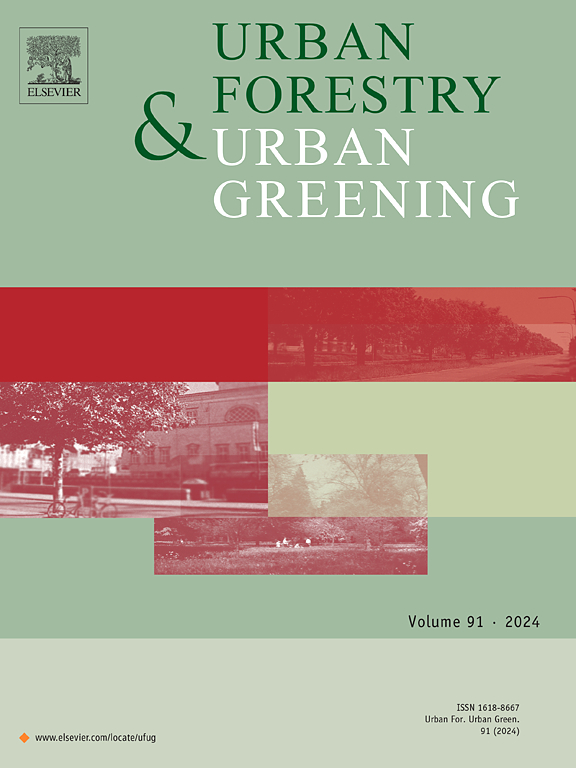Assessing the landscape visual quality of urban green spaces with multidimensional visual indicators
IF 6
2区 环境科学与生态学
Q1 ENVIRONMENTAL STUDIES
引用次数: 0
Abstract
High-quality urban green spaces (UGSs) are crucial for human well-being. Proactive assessment of the landscape visual quality (LVQ) before construction ensures proper alignment with future expectations and reduces resource wastage. In this study, we aimed to use virtual reality (VR) and the multidimensional visual indicators, eye-tracking, image segmentation, and spatial features, to assess the human perception of the LVQ of UGSs. This study encompassed three diverse UGS types across northern, central, and southern China, rendering 30 panoramic images for assessment. Sixty participants assessed these images across seven dimensions: beauty, comfort, color, complexity, liveliness, greenness, and safety. Integrating these multidimensional visual indicators, a generalized estimating equations (GEE) logistic regression model demonstrated superior performance over existing traditional models focusing only on spatial features, facilitating more accurate evaluations of LVQ perception. Moreover, herb plants (eye-tracking indicator), water ratio (image segmentation indicator), and number of materials (spatial feature indicator) were the most positive factors affecting human perception. Isolated planting style positively impacted the perception of greenness, and sky ratio negatively correlated with beauty perception. Additionally, openness levels of 20–80 % enhanced beauty perception, while openness above 80 % decreased liveliness but improved safety perceptions. Shrub species diversity positively correlated with perceptions of greenness and complexity, whereas single and dense shrub arrangements diminish perceptions of greenness and liveliness. Overall, this study provides valuable insights for urban planning at the design stage to enhance decision-making and visual quality of UGSs, thereby contributing to the establishment of more sustainable urban development strategies.
基于多维视觉指标的城市绿地景观视觉质量评价
高质量的城市绿地(UGSs)对人类福祉至关重要。在施工前预先评估景观视觉质量,确保与未来的期望保持一致,并减少资源浪费。在本研究中,我们旨在利用虚拟现实技术和多维视觉指标、眼动追踪、图像分割和空间特征来评估人类对UGSs LVQ的感知。本研究涵盖了中国北部、中部和南部三种不同的UGS类型,绘制了30张全景图像进行评估。60名参与者从7个方面评估这些图片:美丽、舒适、颜色、复杂性、活力、绿色和安全性。综合这些多维视觉指标,广义估计方程(GEE)逻辑回归模型比现有的仅关注空间特征的传统模型表现出更优越的性能,有助于更准确地评估LVQ感知。其中,草本植物(眼动指标)、水分比例(图像分割指标)和材料数量(空间特征指标)是影响人类感知的最积极因素。孤立种植方式正向影响绿化感知,天空比例与美感感知负相关。此外,20 - 80 %的开放程度增强了美感,而超过80% %的开放程度降低了活力,但提高了安全性。灌木物种多样性与绿化和复杂性的感知呈正相关,而单一和密集的灌木排列会降低绿化和活力的感知。总体而言,本研究为设计阶段的城市规划提供了宝贵的见解,以提高uggs的决策和视觉质量,从而有助于制定更可持续的城市发展战略。
本文章由计算机程序翻译,如有差异,请以英文原文为准。
求助全文
约1分钟内获得全文
求助全文
来源期刊

Urban Forestry & Urban Greening
FORESTRY-
CiteScore
11.70
自引率
12.50%
发文量
289
审稿时长
70 days
期刊介绍:
Urban Forestry and Urban Greening is a refereed, international journal aimed at presenting high-quality research with urban and peri-urban woody and non-woody vegetation and its use, planning, design, establishment and management as its main topics. Urban Forestry and Urban Greening concentrates on all tree-dominated (as joint together in the urban forest) as well as other green resources in and around urban areas, such as woodlands, public and private urban parks and gardens, urban nature areas, street tree and square plantations, botanical gardens and cemeteries.
The journal welcomes basic and applied research papers, as well as review papers and short communications. Contributions should focus on one or more of the following aspects:
-Form and functions of urban forests and other vegetation, including aspects of urban ecology.
-Policy-making, planning and design related to urban forests and other vegetation.
-Selection and establishment of tree resources and other vegetation for urban environments.
-Management of urban forests and other vegetation.
Original contributions of a high academic standard are invited from a wide range of disciplines and fields, including forestry, biology, horticulture, arboriculture, landscape ecology, pathology, soil science, hydrology, landscape architecture, landscape planning, urban planning and design, economics, sociology, environmental psychology, public health, and education.
 求助内容:
求助内容: 应助结果提醒方式:
应助结果提醒方式:


